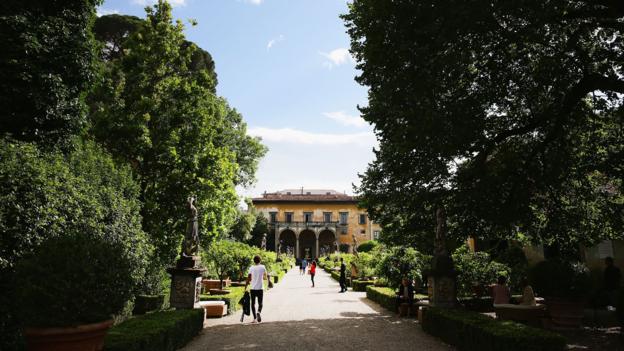This post may contain affiliate links. We may earn money or products from the highlighted keywords or companies or banners mentioned in this post.

My favourite travel quote comes via the Indian poet and Nobel Laureate Rabindranath Tagore. Musing about why he travelled so much, Tagore concluded that he did so “in order to see properly”.
The traveller experiences a place with all five senses, but none is more dominant, more all-embracing, than sight. Or, as another observant traveller, American writer Henry Miller, once said: “One’s destination is never a place, but a new way of seeing things.”
Tagore and Miller were on my mind during a recent visit to Florence. The Italian city –the birthplace of the Renaissance and arguably home to more beauty per square metre than any place in the world – taught me how to see “properly”. I had spent years looking at the world, but looking and seeing are not the same thing.
I had spent years looking at the world, but looking and seeing are not the same thing.
Over the centuries, Florentines have honed the art of seeing. A city of merchants, its residents had to gauge the size of a shipping container or the quality of dye used to make the city’s renowned cloth. Later, the artists of Renaissance Florence, from Botticelli to Ghiberti, would use similar skills to gauge proportion and depth in their artwork.
The Florentines were (and are) notoriously discriminating, if you’re feeling generous; picky, if you’re not. They possess a finely tuned sensitivity for the distinctive and the exquisite, and a visceral disdain for the shoddy and the ordinary. Nothing offends their sensibilities more than something that is a little bit off. A Florentine would rather miss by a mile than an inch.
Florence reveals itself in layers. Literally. The artwork we admire today wasn’t always the first draft. Using X-ray and other technologies, researchers have found layers of previously undetected detail hidden beneath the city’s canvas and wood. And so it is with the city itself. Sure, the Uffizi is the best-known museum, but the Bargello and many other “lesser” museums offer their own beauty.
My favourite is the Specola, the museum of zoology and natural history. It took some work to find. I hit a few dead ends – Italian dead ends, so they were stylish and interesting – before discovering the museum hiding between a cafe and a tobacco shop. Forsaken and sad looking, the Specola gets few visitors.
That’s a shame, for it has its own charms. In fact, I didn’t know they made museums like this anymore. Stuffed animals were displayed behind grimy glass cases: cheetahs, hyenas, walruses and zebras, all with the same frozen expression, a combination of shock and repose, as if they had no idea how they ended up here but were resigned to their fate nonetheless. It was all very 19th Century. I half expected Charles Darwin to pop up at any moment.
The past, it’s been said, is a foreign country. They do things differently there. The Florence of today is, of course, very different from the Florence of Michelangelo and Leonardo’s day. The Florence of today has pizza and pasta and espresso and wi-fi and tour buses. What to do?
“Squint.”
That was the advice of a friend back home when I’d mentioned my plans to visit Florence. I’d laughed it off, but I now realized it’s actually a smart tactic. As the great psychologist William James said, “The art of being wise is the art of knowing what to overlook.” Sometimes we can see more by narrowing our field of view than by expanding it. The zoom lens reveals as much as the wide angle, and sometimes more. And so I zoomed, blocking out the tour buses and the pizza joints and the street vendors hawking velvet paintings of Bob Marley.
The art of being wise is the art of knowing what to overlook.
If you want to “see properly”, it helps to have a sharp-eyed guide. Mine was Eugene Martinez. I liked the name of his tour company, Ars Opulenta, which is Latin for “abundantly luxuriant art”. It sounded unapologetically decadent and overflowing with goodness.
What really sold me on Martinez, though, was his dog. While the other websites featured sombre men and women striking serious art-is-no-laughing-matter poses in front of some sober Florentine landmark, the Ars Opulenta page greeted me with a photo of Martinez and a hound of indeterminate breed. Both were smiling, with the red-tiled roof and shiny gold spire of the Duomo barely visible in the distance. The dog was no accident. He’s good for business. Dogs are comforting, reassuring, while all this art, this genius, is intimidating. What if we don’t “get” it? What if we say something silly that exposes our ignorance? What if we are not worthy? A smiling canine presence puts people at ease.
In the days I spent with Martinez, walking the cobblestoned streets of Florence, visiting the Bargello and one of the city’s still-functioning tile workshops, he taught me how to see the artwork for its own sake, on its own terms, and not burdened with expectations of what I should be seeing.
I liked the way Martinez said crazy, blasphemous things, such as “I don’t care for the Renaissance.”
“What?” I replied, dumbstruck. “You don’t like the Renaissance?”
“I don’t. It’s too pretty for me.” I was pondering what he meant by that when he said,
“Give it a few days. You’ll see what I mean.”
A week later, at the Pitti Palace, I did. While most buildings in Florence are the epitome of sophisticated understatement, the Pitti Palace is huge and garish. It’s an architectural emoticon, a monument to excess. Walking down one of the oversized corridors, ogling the David knockoffs, past the inlaid tiles and the ornate tapestries, I realized, finally, what Martinez meant when he said that the Renaissance was too pretty for him.
He meant too “pretty” in the sense of too flowery, overwrought. Some art simply tries too hard to please. This doesn’t apply to all Renaissance art, of course. Some of it is absolutely worthy of our affection – but that’s a judgment we need to make ourselves rather than blindly following the lead of an art historian, or anyone else for that matter. By pretending that all Renaissance art is equally good, we undeservedly elevate the bad art and do a disservice to the abundance of great art that the Renaissance did produce.
And, more importantly, we betray our own eyes – our own hard-earned ability to see properly.
Seeing art, it turns out, is less important than the art of seeing.
Eric Weiner is a recovering malcontent and philosophical traveller. He is the author of, among other books, The Geography of Bliss and the forthcoming The Geography of Genius. Follow him on Twitter.
If you liked this story, sign up for the weekly bbc.com features newsletter, called “If You Only Read 6 Things This Week”. A handpicked selection of stories from BBC Future, Earth, Culture, Capital, Travel and Autos, delivered to your inbox every Friday.










